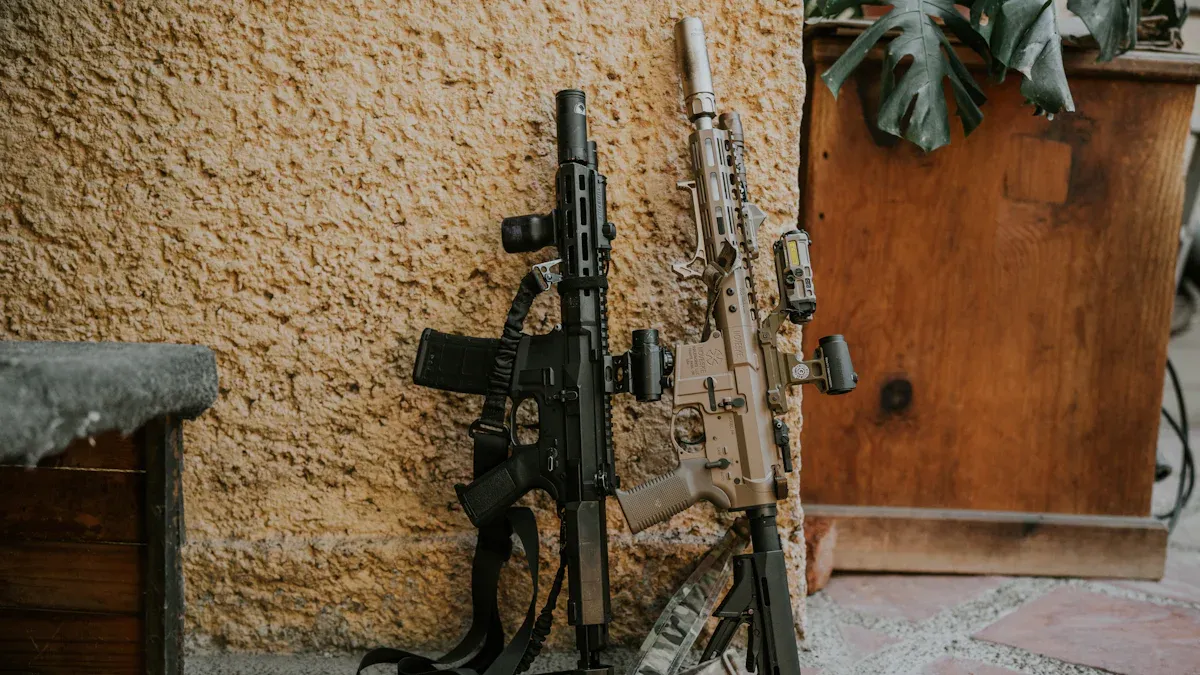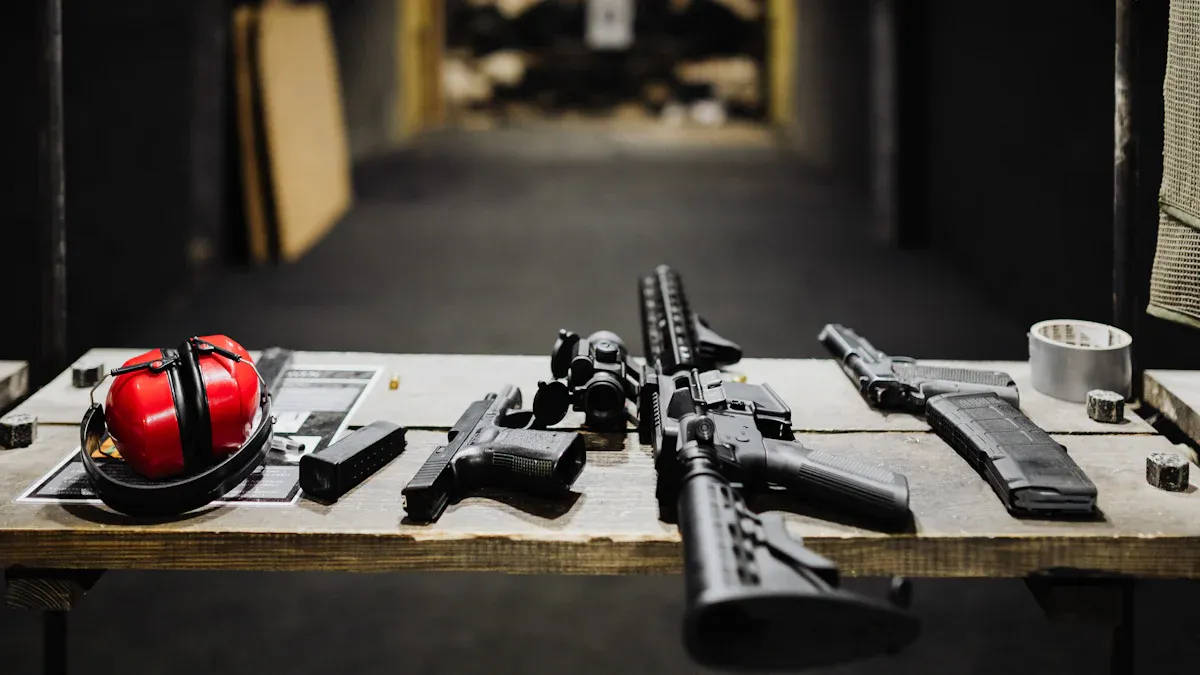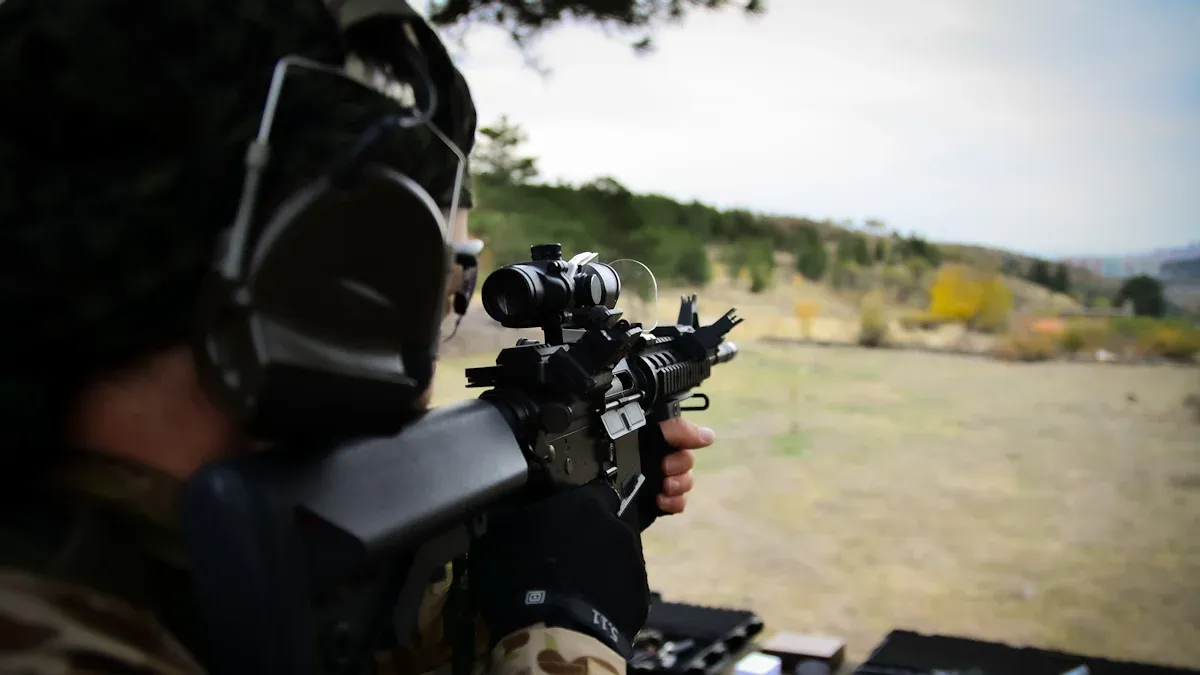
Quick-deploy rifle bipods revolutionize competitive shooting by providing unmatched stability and precision. Their ability to stabilize the rifle allows shooters to manage recoil effectively and observe impacts through the rifle scope. This setup significantly increases the likelihood of hitting targets. In time-sensitive matches, these bipods save crucial seconds, offering a competitive edge. Their adaptability to various rail systems and mounts ensures seamless integration with other accessories, making them indispensable for dynamic shooting scenarios.
Key Takeaways
- Quick-deploy bipods help shooters set up fast in matches. This saves time and keeps them competitive.
- Staying steady is key for good aim. Quick-deploy bipods reduce shaking, making shots more accurate.
- Adjustable legs make these bipods work on different grounds. Shooters can use them in many positions.
Benefits of Quick-Deploy Rifle Bipods

Faster Setup for Time-Sensitive Matches
Quick-deploy rifle bipods excel in competitive shooting by reducing setup time, a critical factor in time-sensitive matches. Modern designs allow shooters to transition seamlessly between positions, ensuring they stay ahead of the clock. Features like spring tension mechanisms enhance deployment speed while maintaining stability. Competitive shooters often favor the Harris bipod for its quick deployment and reduced recoil “hop,” which aids in shot visibility. In NRL Hunter competitions, the triple-pull version proves invaluable for adjusting to kneeling height, especially in environments with tall grass. These features make quick-deploy bipods indispensable for high-pressure scenarios.
Improved Stability for Precision Shooting
Stability is the cornerstone of precision shooting, and quick-deploy rifle bipods deliver exceptional performance in this area. Their sturdy construction minimizes movement, allowing shooters to maintain a steady aim. This reliability becomes crucial during competitive matches where even minor shifts can affect accuracy. A competitor shared their experience with a premium bipod model, emphasizing its sturdiness and quick deployment as key factors in achieving success. By reducing recoil “hop,” these bipods enable shooters to spot their shots more effectively, further enhancing precision.
Adaptability in Dynamic Shooting Scenarios
Dynamic shooting scenarios demand equipment that can adapt to varying terrains and shooting angles. Quick-deploy rifle bipods meet this challenge with adjustable legs and versatile designs. The Harris bipod, for instance, offers stability and quick deployment, making it a favorite among top shooters. Austin Orgain, a two-time PRS Champion, highlighted the MDT Ckye-Pod’s versatility, particularly its adjustability for shooting on slopes. These features ensure that shooters can perform consistently, regardless of the environment.
Real-Life Example: How the Harris S-BRM Bipod Helped a Shooter Win a PRS Match
The Harris S-BRM bipod has proven its effectiveness in competitive shooting. A recent report revealed that 18% of competitors and 40% of the top 10 shooters in PRS matches relied on this model. Its quick deployment and stability played a significant role in their success. The bipod’s ability to reduce recoil “hop” and maintain a steady aim gave these shooters a competitive edge, demonstrating why it remains a trusted choice in the field.
Key Features to Look For in a Rifle Bipod
Material Durability for Long-Term Use
Durability is a critical factor when selecting a rifle bipod. Competitive shooters often rely on models constructed from high-quality materials like aircraft-grade aluminum or carbon fiber. These materials resist wear and tear, ensuring the bipod performs reliably over time. For instance, the Harris Bipod is renowned for its robust build, which withstands the rigors of frequent use. Its simple yet sturdy design has made it a trusted choice among 45% of top shooters in competitive matches.
Lightweight Design for Easy Maneuverability
A lightweight rifle bipod enhances maneuverability, especially during dynamic shooting scenarios. Models like the Magpul Bipod, weighing only 11.8 oz, maintain firearm balance without compromising stability. The MOE variant, at just 8 oz, offers even greater ease of handling. These lightweight designs allow shooters to make quick adjustments, a crucial advantage in fast-paced competitions.
Adjustable Legs for Versatile Shooting Angles
Adjustable legs provide the flexibility needed for various shooting positions and terrains. The Skyline Pro bipod, for example, offers three stance angles—72, 48, and 22 degrees—allowing shooters to adapt to uneven surfaces. Its innovative mechanism enables simultaneous leg adjustments with a single button press, ensuring rapid transitions. Similarly, Atlas Bipods are favored for their ability to accommodate different shooting scenarios, making them ideal for competitive environments.
Smooth Deployment Mechanisms for Quick Action
Quick deployment mechanisms are essential for time-sensitive matches. Bipods like the Harris model feature spring tension systems that enable rapid setup in under two seconds. This efficiency ensures shooters can focus on their targets without losing valuable time. The Atlas Bipod also excels in this area, offering smooth and reliable deployment for consistent performance.
Real-Life Example: Comparing the Atlas BT10 V8 and MDT Ckye-Pod for Competitive Shooting
The Atlas BT10 V8 and MDT Ckye-Pod are two popular choices among competitive shooters. The Atlas BT10 V8 stands out for its affordability and versatility, featuring adjustable legs that extend from 6.5 to 10 inches. It provides solid support and adapts well to various terrains. On the other hand, the MDT Ckye-Pod is preferred for its speed and support capabilities. Its single-pull leg design and adjustable heights (9.5 to 14.5 inches) make it a top choice for PRS and racegun competitions. Both models deliver exceptional performance, but the choice often depends on the shooter’s specific needs.
How to Use Quick-Deploy Rifle Bipods Effectively
Proper Setup for Maximum Stability
Achieving maximum stability with a quick-deploy rifle bipod requires careful setup. Shooters should begin by ensuring the bipod is securely attached to the rifle’s mounting system. Adjusting the legs to the appropriate height for the terrain and shooting position is essential. Practicing with the rifle and optics in various configurations helps shooters become familiar with their equipment. Regularly testing adjustments to the bipod, scope, and other components during training stages enhances confidence and efficiency. Incorporating supportive gear, such as shooting bags, further improves stability and deployability. These steps allow shooters to maintain a steady aim, even in challenging conditions.
Ideal Positioning for Different Shooting Scenarios
Quick-deploy rifle bipods enable shooters to adapt to various positions, including prone, sitting, and standing. This versatility proves invaluable in dynamic shooting environments where conditions change rapidly. For example, prone positioning offers the most stability for long-range shots, while sitting or kneeling positions are better suited for uneven terrain. Modern bipods allow seamless transitions between these positions, ensuring shooters can respond effectively to match requirements. Practicing these transitions during training ensures smooth execution during competitions.
Maintenance Tips to Ensure Longevity
Proper maintenance extends the lifespan of a rifle bipod and ensures consistent performance. After each use, shooters should clean the bipod to remove dirt and debris, especially from the leg joints and locking mechanisms. Applying a light lubricant to moving parts prevents rust and ensures smooth operation. Periodically inspecting for wear and tear, such as loose screws or damaged components, helps identify issues before they affect performance. Storing the bipod in a dry, secure location protects it from environmental damage. These practices keep the bipod in optimal condition for future use.
Real-Life Example: A Shooter’s Routine for Setting Up and Maintaining the Accu Tac Bipod
A competitive shooter shared their routine for using and maintaining the Accu Tac Bipod. Before each match, they ensure the bipod is securely mounted and adjust the legs to the desired height. During practice, they train in deploying the bipod quickly and transitioning between positions. After each session, they clean the bipod thoroughly, paying special attention to the leg joints. They also apply lubricant to the moving parts and check for any signs of wear. This routine has helped them achieve consistent performance and maintain the bipod’s reliability over time.
Top Quick-Deploy Rifle Bipods for Competitive Shooting

Harris S-BRM 6-9” Bipod – Features and Price
The Harris S-BRM 6-9” bipod remains a trusted choice among competitive shooters. Its lightweight yet durable construction ensures long-term reliability. The bipod features spring-loaded legs that adjust between 6 and 9 inches, providing flexibility for various shooting positions. Its swivel base allows for easy cant adjustments, making it suitable for uneven terrain. Priced around $120 to $150, the Harris S-BRM offers excellent value for its performance. Many shooters, including professionals, continue to rely on this model for its quick deployment and stability.
Accu Tac Bipod – Features and Price
The Accu Tac SR-5 Quick Detach bipod stands out for its exceptional durability. Constructed from aircraft-grade aluminum, it withstands rigorous use without compromising performance. Users have praised its ability to endure harsh conditions, outperforming even more expensive models. The bipod’s quick-detach mechanism ensures seamless attachment and removal, while its adjustable legs provide versatility for different shooting angles. Priced between $300 and $400, the Accu Tac SR-5 delivers premium quality at a competitive price point.
MDT Ckye-Pod – Features and Price
The MDT Ckye-Pod is a top-tier option for competitive shooters seeking maximum adjustability. Its legs extend from 6.6 to 36.9 inches, accommodating a wide range of shooting positions. The bipod offers 170° cant and 360° pan capabilities, ensuring adaptability in dynamic scenarios. While its deployment speed is slower than some competitors, its precision engineering and tight lockup make it a favorite among 71% of top shooters. Priced between $600 and $1,000, the Ckye-Pod represents a significant investment but delivers unmatched performance.
| Feature | MDT Ckye-Pod | Other Bipods (e.g., Harris, Thunder Beast) |
|---|---|---|
| Price | $600 to $1,000 | Varies, generally lower |
| Height Adjustability | 6.6″ to 36.9″ | Limited adjustability |
| Cant | 170° | Typically less |
| Pan | 360° (lockable) | Varies |
| Deployment Speed | Slower compared to others | Generally faster |
| Lockup Tightness | Some play reported | Tighter lockup |
| User Preference | 71% of top shooters use it | Varies |
Atlas BT10 V8 Bipod – Features and Price
The Atlas BT10 V8 bipod combines precision engineering with robust construction. Made from high-grade aluminum and stainless steel, it withstands harsh conditions while maintaining performance. Its legs lock firmly into multiple positions, minimizing movement for improved accuracy. The bipod’s tension adjustments allow for smooth deployment and secure positioning. With a price range of $250 to $300, the Atlas BT10 V8 offers excellent value through its durability, versatility, and modularity.
- Build Quality: High-grade aluminum and stainless steel ensure durability.
- Versatility: Multiple leg positions enhance adaptability.
- Precision Engineering: Firm leg locks reduce movement for better accuracy.
- Smooth Operation: Tension adjustments provide quick deployment.
- Modularity: Various mounting options support customization.
Real-Life Example: Why Competitive Shooters Prefer These Models
Competitive shooters often choose these bipods for their reliability and performance. The Harris S-BRM remains popular for its quick deployment and affordability, with 18% of professional shooters using it. The MDT Ckye-Pod dominates the field, with 57% of pros relying on it for its adjustability and stability. Austin Orgain, a two-time PRS Champion, highlights the Harris bipod’s versatility in varied terrain. These models consistently deliver the stability and precision required for competitive success.
Quick-deploy rifle bipods transform competitive shooting by enhancing stability, accuracy, and adaptability. Their rapid deployment and versatility allow shooters to excel in dynamic environments.
- Shooters achieve tight groupings at over 800 yards.
- Seamless transitions between positions save time.
- Stability ensures success in varied terrains.
Investing in a high-quality bipod elevates performance and ensures consistent results.
FAQ
What is the primary purpose of a rifle bipod in competitive shooting?
A rifle bipod provides stability, enabling shooters to maintain accuracy during matches. It minimizes movement, reduces recoil, and ensures consistent performance across various shooting scenarios.
How do adjustable legs improve a rifle bipod’s functionality?
Adjustable legs allow shooters to adapt to different terrains and shooting angles. This feature enhances versatility, making the bipod suitable for dynamic and uneven environments.
Can a rifle bipod be used with all rifles?
Most rifle bipods are compatible with standard mounting systems. However, shooters should verify compatibility with their specific rifle model before purchasing.
Post time: Mar-25-2025
